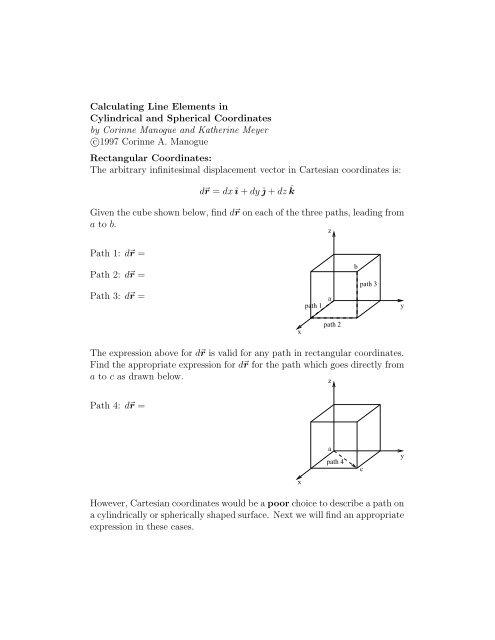Calculating Line Elements in Cylindrical and Spherical Coordinates ...
Calculating Line Elements in Cylindrical and Spherical Coordinates ... Calculating Line Elements in Cylindrical and Spherical Coordinates ...
Calculating Line Elements inCylindrical and Spherical Coordinatesby Corinne Manogue and Katherine Meyerc○1997 Corinne A. ManogueRectangular Coordinates:The arbitrary infinitesimal displacement vector in Cartesian coordinates is:d⃗r = dx î + dy ĵ + dz ˆkGiven the cube shown below, find d⃗r on each of the three paths, leading froma to b.zPath 1: d⃗r =Path 2: d⃗r =Path 3: d⃗r =path 1abpath 3yxpath 2The expression above for d⃗r is valid for any path in rectangular coordinates.Find the appropriate expression for d⃗r for the path which goes directly froma to c as drawn below.Path 4: d⃗r =zapath 4cyxHowever, Cartesian coordinates would be a poor choice to describe a path ona cylindrically or spherically shaped surface. Next we will find an appropriateexpression in these cases.
- Page 2 and 3: Cylindrical Coordinates:SEE DIAGRAM
- Page 4: zθlength=path 1(r, θ, φ)=apath 2
<strong>Calculat<strong>in</strong>g</strong> <strong>L<strong>in</strong>e</strong> <strong>Elements</strong> <strong>in</strong>Cyl<strong>in</strong>drical <strong>and</strong> <strong>Spherical</strong> Coord<strong>in</strong>atesby Cor<strong>in</strong>ne Manogue <strong>and</strong> Kather<strong>in</strong>e Meyerc○1997 Cor<strong>in</strong>ne A. ManogueRectangular Coord<strong>in</strong>ates:The arbitrary <strong>in</strong>f<strong>in</strong>itesimal displacement vector <strong>in</strong> Cartesian coord<strong>in</strong>ates is:d⃗r = dx î + dy ĵ + dz ˆkGiven the cube shown below, f<strong>in</strong>d d⃗r on each of the three paths, lead<strong>in</strong>g froma to b.zPath 1: d⃗r =Path 2: d⃗r =Path 3: d⃗r =path 1abpath 3yxpath 2The expression above for d⃗r is valid for any path <strong>in</strong> rectangular coord<strong>in</strong>ates.F<strong>in</strong>d the appropriate expression for d⃗r for the path which goes directly froma to c as drawn below.Path 4: d⃗r =zapath 4cyxHowever, Cartesian coord<strong>in</strong>ates would be a poor choice to describe a path ona cyl<strong>in</strong>drically or spherically shaped surface. Next we will f<strong>in</strong>d an appropriateexpression <strong>in</strong> these cases.
Cyl<strong>in</strong>drical Coord<strong>in</strong>ates:SEE DIAGRAM ON NEXT PAGEYou will now derive the general form for d⃗r <strong>in</strong> cyl<strong>in</strong>drical coord<strong>in</strong>ates bydeterm<strong>in</strong><strong>in</strong>g d⃗r along the specific paths below.Note that an <strong>in</strong>f<strong>in</strong>itesmial element of length <strong>in</strong> the ˆr direction is simply dr,just as an <strong>in</strong>f<strong>in</strong>itesimal element of length <strong>in</strong> the î direction is dx. But, an<strong>in</strong>f<strong>in</strong>itesimal element of length <strong>in</strong> the ˆφ direction is not just dφ, s<strong>in</strong>ce thiswould be an angle <strong>and</strong> does not even have the units of length.Geometrically determ<strong>in</strong>e the length of the three paths lead<strong>in</strong>g from a to b<strong>and</strong> write these lengths <strong>in</strong> the correspond<strong>in</strong>g boxes on the diagram.Now, remember<strong>in</strong>g that d⃗r has both magnitude <strong>and</strong> direction, write downbelow the <strong>in</strong>f<strong>in</strong>tesimal displacement vector d⃗r along the three paths from ato b. Notice that, along any of these three paths, only one coord<strong>in</strong>ate r, φ, orz is chang<strong>in</strong>g at a time. (i.e. along path 1, dr ≠ 0, but dφ = 0 <strong>and</strong> dz = 0).Path 1: d⃗r =Path 2: d⃗r =Path 3: d⃗r =If all three coord<strong>in</strong>ates are allowed to change simultaneously, by an <strong>in</strong>f<strong>in</strong>itesimalamount, we could write this d⃗r for any path as:d⃗r=This is the general l<strong>in</strong>e element <strong>in</strong> cyl<strong>in</strong>drical coord<strong>in</strong>ates.
zpath 3length=(r+dr, φ+ d φ,z+dz)=ba= (r, φ,z)path 1length=path 2length=yxφdφ<strong>L<strong>in</strong>e</strong> <strong>Elements</strong> <strong>in</strong> Cyl<strong>in</strong>drical Coord<strong>in</strong>ates
zθlength=path 1(r, θ, φ)=apath 2path 3length=dθlength=b=(r+dr, θ+d θ, φ +d φ)xφdφ<strong>L<strong>in</strong>e</strong> <strong>Elements</strong> <strong>in</strong> <strong>Spherical</strong> Coord<strong>in</strong>ates<strong>Spherical</strong> Coord<strong>in</strong>ates:You will now derive the general form for d⃗r <strong>in</strong> spherical coord<strong>in</strong>ates by determ<strong>in</strong><strong>in</strong>gd⃗r along the specific paths below. As <strong>in</strong> the cyl<strong>in</strong>drical case, notethat an <strong>in</strong>f<strong>in</strong>itesmial element of length <strong>in</strong> the ˆθ or ˆφ direction is not justdθ or dφ. You will need to be more careful. Geometrically determ<strong>in</strong>e thelength of the three paths lead<strong>in</strong>g from a to b <strong>and</strong> write these lengths <strong>in</strong> thecorrespond<strong>in</strong>g boxes on the diagram. Now, remember<strong>in</strong>g that d⃗r has bothmagnitude <strong>and</strong> direction, write down below the <strong>in</strong>f<strong>in</strong>tesimal displacementvector d⃗r along the three paths from a to b. Notice that, along any of thesethree paths, only one coord<strong>in</strong>ate r, θ, or φ is chang<strong>in</strong>g at a time. (i.e. alongpath 1, dr ≠ 0, but dθ = 0 <strong>and</strong> dφ = 0).Path 1: d⃗r =Path 2: d⃗r =Path 3: d⃗r =y(Be careful, this is the tricky one.)If all 3 coord<strong>in</strong>ates are allowed to change simultaneously, by an <strong>in</strong>f<strong>in</strong>itesimalamount, we could write this d⃗r for any path as:d⃗r=This is the general l<strong>in</strong>e element <strong>in</strong> spherical coord<strong>in</strong>ates.



